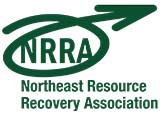Waste Reduction and Diversion
Reducing the generation of waste and diverting recoverable materials from disposal.
The Solid Waste Management Act establishes a waste reduction goal (RSA 149-M:2) and a hierarchy or preferred waste management methods (RSA 149-M:3) in order to encourage and support an integrated system of waste management that reduces the generation of waste where possible, while also managing the waste that is generated in the most environmentally-responsible manner available. While the Solid Waste Management Act does not establish waste reduction or recycling as mandatory practices in New Hampshire, the statute does encourage management of wastes in accordance with the Waste Management Hierarchy and discourages disposal of recyclables by landfilling or incineration.
Related Content
New Hampshire’s Waste Management Hierarchy
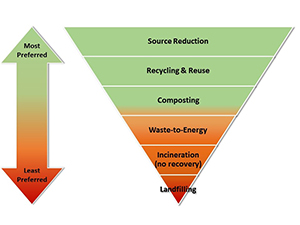 New Hampshire’s Waste Management Hierarchy provides a standard of preference for management of solid waste in the state, with priority placed on approaches that reduce the generation of waste or divert recoverable materials from disposal in landfills or incinerators. Source reduction (that is, reducing generation of waste at the source) is at the top of the hierarchy because such practices prevent waste from being generated, which results in less waste needing end-of-life management, conservation of resources, and reduction in overall environmental impacts. Of course, it is not always feasible to reduce or prevent waste from being generated. Therefore, the next preference on the hierarchy is diversion. The concept of diversion includes management methods that recover discarded materials so that they are reused or repurposed instead of disposed in a landfill or incinerator. This includes methods such as recycling and composting. Next on the hierarchy are waste-to-energy technologies, including incineration with energy recovery, anaerobic digestion, and emerging conversion processes that turn waste into fuel. These technologies are preferable to traditional disposal methods because they can recover energy, reduce volume and weight, and in some cases produce useful by-products. Meanwhile, traditional disposal methods such as landfilling and incineration without energy recovery have lowest preference on the hierarchy and should be reserved for wastes that cannot be source-reduced or diverted.
New Hampshire’s Waste Management Hierarchy provides a standard of preference for management of solid waste in the state, with priority placed on approaches that reduce the generation of waste or divert recoverable materials from disposal in landfills or incinerators. Source reduction (that is, reducing generation of waste at the source) is at the top of the hierarchy because such practices prevent waste from being generated, which results in less waste needing end-of-life management, conservation of resources, and reduction in overall environmental impacts. Of course, it is not always feasible to reduce or prevent waste from being generated. Therefore, the next preference on the hierarchy is diversion. The concept of diversion includes management methods that recover discarded materials so that they are reused or repurposed instead of disposed in a landfill or incinerator. This includes methods such as recycling and composting. Next on the hierarchy are waste-to-energy technologies, including incineration with energy recovery, anaerobic digestion, and emerging conversion processes that turn waste into fuel. These technologies are preferable to traditional disposal methods because they can recover energy, reduce volume and weight, and in some cases produce useful by-products. Meanwhile, traditional disposal methods such as landfilling and incineration without energy recovery have lowest preference on the hierarchy and should be reserved for wastes that cannot be source-reduced or diverted.
Waste Disposal Bans
In New Hampshire, there are 5 types of waste that are banned from disposal in landfills and incinerators. These disposal bans are established by law in RSA 149-M:27 and RSA 149-M:58 (mercury-added products). Click through the tabs below to learn more.
 Est. 2007
Est. 2007
Some electronics are banned from disposal in landfills and incinerators:
- Video display devices (i.e. projectors and TV’s).
- Central Processing Units (CPUs) from computers.
- Non-mobile video display media recorders/players (i.e. VCR and DVD players).
These items contain heavy metals such as lead, cadmium and mercury. Exposure to heavy metals can cause major human health and environmental problems.
Recycle electronics through your local transfer station, collection event or at certain retail locations.
At this time, this ban does not apply to households.
Effective February 1, 2025, certain entities will be prohibited from disposing of food waste in a landfill and incinerator. This ban applies to entities (institutions, restaurants, grocery stores, etc.) that generate 1+ tons of food waste per week and are located within 20 miles of a facility with the capacity to manage excess food.
Food waste prohibited from disposal must be separated and managed through one or more of the following methods, in order of preference:
- Source reduction.
- Feeding people.
- Feeding animals.
- Composting, digestion, or land application (as appropriate).
- Energy recovery not involving combustion.
 Est. 1993
Est. 1993
It is against the law to dispose of yard waste in landfills and incinerators. This includes leaves, grass clippings, garden debris, and small or chipped branches. It’s also illegal to dump them in a wetland area without a permit. Learn about your options to manage leaf and yard waste.
NOTE: Invasive plants can go in the trash! Do not put invasive plants with your leaf and yard waste or compost pile!
Est. 2008
Mercury-added products are prohibited from disposal in landfills and incinerators because mercury is a heavy metal that poses a threat to public and environmental health.
These products can include:
- Button cell batteries.
- Compact fluorescent lightbulbs (CFLs).
- Fluorescent lamps.
- Thermometers (with silver liquid).
- Thermostats.
- Tilt switches.
Learn about your options for managing these devices.
 Est. 1991
Est. 1991
Wet-cell batteries are banned from disposal. The most common are automotive (car) and large equipment batteries, which contain sulfuric acid and lead. Acid is corrosive so it can burn skin and eyes.
Have an old car battery?
- Return it when purchasing a new car battery.
- Recycle at a transfer station, scrap metal yard or auto repair shop.
Learn about how to manage your batteries.
NH Solid Waste Working Group
The Solid Waste Working Group is a statutory committee responsible for assisting NHDES with solid waste planning and policy initiatives. The Working Group’s responsibilities include reviewing New Hampshire’s solid waste reduction, recycling and management policies, programs, goals and initiatives, and providing recommendations for changes.
- Certified Waste-Derived Products
- Solid Waste Management Plan
- Biennial Solid Waste Reports
- Motor Vehicle Salvage Yards
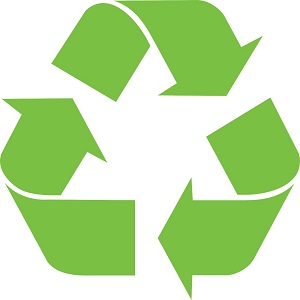 Turning waste into usable products
Turning waste into usable products
A waste-derived product is a material or item which is produced, in whole or in part, using materials or items which are recovered or diverted from the solid waste stream. Waste-derived products must be certified for distribution and use in New Hampshire. Production, use, and distribution of a certified waste-derived product may be subject to specific terms, restrictions, and specifications.
 Solid waste strategic goals and objectives
Solid waste strategic goals and objectives
The New Hampshire Solid Waste Management Plan contains strategic goals and objectives for management of solid waste in the State that support and uphold the provisions of the Solid Waste Management Act (RSA 149-M).
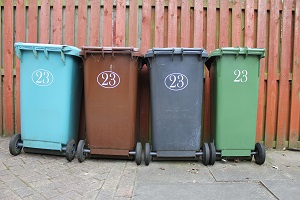 Assessing progress toward New Hampshire's waste reduction goals
Assessing progress toward New Hampshire's waste reduction goals
The Biennial Solid Waste Report provides information about the State’s waste reduction goal established by RSA 149-M:2, as well as other details related to solid waste management in New Hampshire.
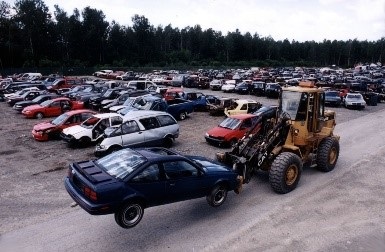 Improving environmental practices and ensuring regulatory compliance
Improving environmental practices and ensuring regulatory compliance
Motor vehicle salvage yards play an important role in recovering and recycling end-of-life motor vehicles. Up to 85% of the material in motor vehicles, by weight, is recyclable. NHDES provides industry specific Best Management Practices to motor vehicle recyclers to help improve environmental practices and maintain compliance at their facilities. The program also works closely with municipalities to facilitate appropriate licensing and oversight of these important facilities within their communities.







